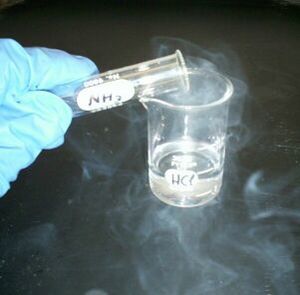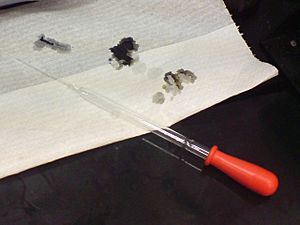Acid facts for kids

An acid is a special kind of chemical substance. It has many tiny parts called hydrogen ions (H+) that it can give away to other substances. Think of these ions like tiny building blocks.
Some acids are "strong" and can give away most or all of their hydrogen ions. Other acids are "weak" and hold onto some of their ions.
A base is like an acid's chemical opposite. A base is a substance that can take an acid's hydrogen ions. It also has many hydroxide ions that it can release.
Contents
The pH Scale: Measuring Acids
Scientists use a special tool called the pH scale to measure how acidic or basic a liquid is. This scale gives a number to each substance.
- The lowest number is 0, which means it's extremely acidic.
- The highest number is 14, which means it's extremely basic.
- The number 7 is called "neutral." This means it's neither acidic nor basic.
- For example, pure distilled water has a pH of 7.
Properties of Acids
Acids can have different strengths. This depends on how many hydrogen ions they have. Stronger acids are very dangerous. You should never touch them without an adult's help. They can cause a chemical reaction that will burn your skin. Strong bases can also cause burns. If you get a chemical burn, it needs to be treated right away.
Most acids share some common properties:
- They taste sour if you eat them. Think of a lemon!
- They can sting or burn your skin if you touch them.
- They can corrode (eat away at) metals and skin.
- They can help conduct electricity.
- They turn blue litmus paper red.
- They turn red or orange when tested with a universal indicator. This is a special liquid used to measure pH.
Why Acids Are Important
Acids are super important for living things and in many parts of our daily lives.
- Genetic Code: Special acids called nucleic acids, like DNA and RNA, hold the genetic code of all living things. These molecules carry the instructions that make you who you are, passed down from your parents. DNA contains the detailed plans for building proteins, which are made of amino acids.
- Body Fuel: Fatty acids are important sources of fuel for your body. They work with your cells to create energy.
- Digestion: Hydrochloric acid is part of the gastric acid in your stomach. It helps you and many animals digest food.
Some acids you can find in nature or everyday life include:
- Vinegar: This is a very well-known acid. It's often used in foods and for cleaning.
- Nitric acid: This acid is used in rocket fuels and explosives.
- Citric acid: You can find this acid in fruits like lemons, grapefruits, and oranges. It gives them their sour taste.
- Lactic acid: This acid is found in sour milk products like yogurt.
- Sulfuric acid: This is a thick, clear liquid. It can dissolve in water and melt weak substances. It is found in batteries.
Interesting Facts About Acids
- An acid is a substance that can give away one or more of its hydrogen ions to another substance.
- Strong acids let go of many or all of their ions.
- Weak acids hold onto some of their ions.
- The opposite of an acid is a base.
- Acids taste sour and can burn things like skin and even metal.
- Some of the most important acids are DNA and RNA. These molecules contain the genetic code of living things.
- Acids can be found naturally in the human body and in nature.
Images for kids
-
Zinc, a typical metal, reacting with hydrochloric acid, a typical acid.
-
Acetic acid, a weak acid, gives a proton (hydrogen ion, highlighted in green) to water. This creates the acetate ion and the hydronium ion. Red is oxygen, black is carbon, white is hydrogen.
-
This graph shows an ideal titration curve for alanine, a type of amino acid. Point 2 is where the amount of NaOH added equals the amount of alanine.
See also
 In Spanish: Ácido para niños
In Spanish: Ácido para niños







